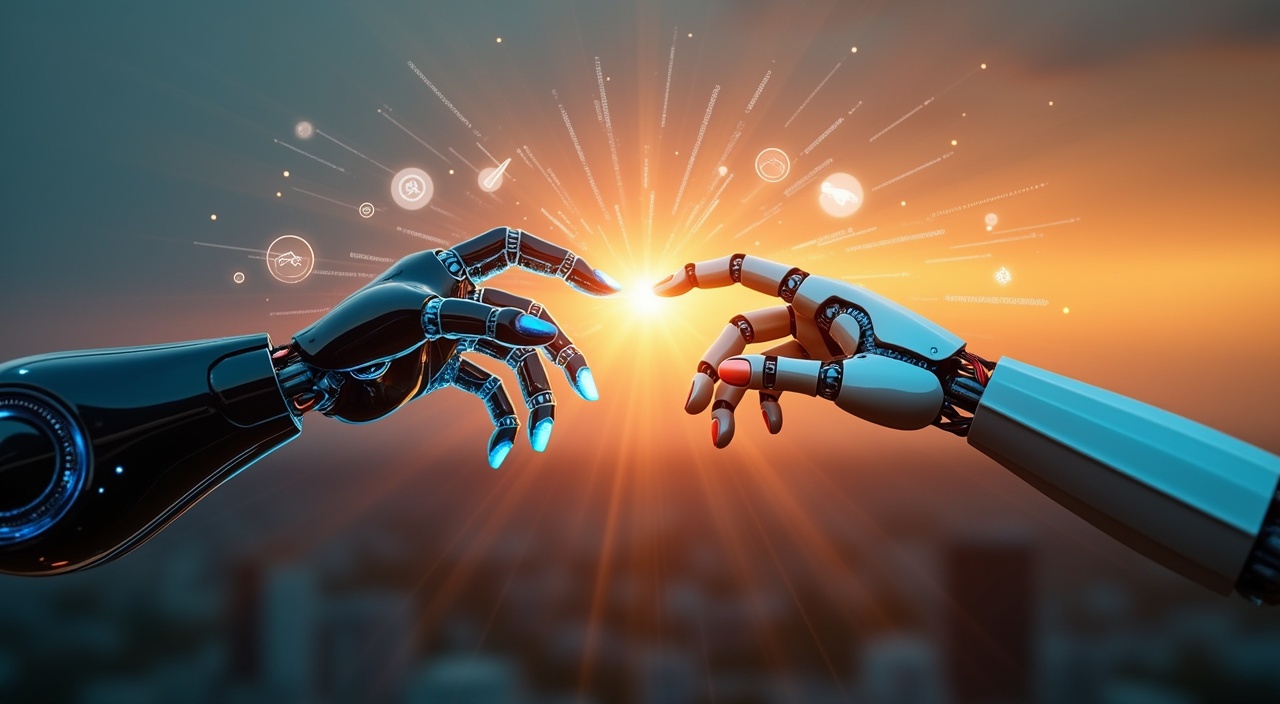AI has dramatically transformed from a perceived threat to a powerful collaborative partner, with humans emerging as the true architects of technological advancement. By treating AI as a strategic ally instead of a replacement, individuals and companies are finding new paths to innovation, better productivity, and fresh approaches to solving complex problems.
Key Takeaways:
- AI amplifies human abilities rather than replacing workers, with 97 million people projected to work in AI-related roles
- Effective AI integration focuses on boosting human potential through strategic teamwork
- Global views on AI are changing, showing greater optimism and clearer understanding of real-world applications
- Humans remain essential to AI development, pushing innovation through creative solutions and ethical frameworks
- AI tools are becoming easier to access, bringing advanced technological capabilities to individuals and small businesses
I’ve seen this transformation firsthand in my work with small business owners. Like you, I initially approached AI with caution, wondering if it would eliminate jobs rather than create opportunities. But the evidence tells a different story.
The future isn’t about AI replacing us—it’s about how we adapt to working alongside these tools. This shift reminds me of when I first moved from Europe to the U.S. and had to adapt to a new business environment. Change creates opportunity for those willing to embrace it.
Human-AI Collaboration Creates New Value
Recent studies show that professionals who strategically use AI tools increase their productivity by up to 40% compared to those who don’t. This isn’t about replacing jobs—it’s about changing how we work.
Here’s what I mean: When I started using AI to handle basic research and first drafts, I freed up time to focus on strategy and client relationships—the parts of business that machines can’t replicate. The result? More client value and greater satisfaction with my work.
Picture this: A small accounting firm uses AI to automate data entry and basic calculations. Instead of replacing staff, this allows accountants to spend more time consulting with clients, identifying tax savings, and building relationships. The business grows because humans do what they do best—connect, create, and problem-solve.
The Global Perspective is Shifting
The fear of AI is giving way to practical optimism. Across industries, professionals are finding that AI tools enhance rather than diminish their roles.
Strange but true: In a recent survey of business leaders, 67% reported that AI implementation actually increased hiring in their organizations. The catch? These new roles require different skills than before.
I’ve worked with clients in healthcare, legal services, and retail who initially feared AI would make their expertise obsolete. Instead, they discovered that combining human intuition with AI capabilities created services their competitors couldn’t match.
Humans Drive AI Development
Let’s be clear: AI doesn’t improve itself. Human innovation, creativity, and ethical guidance remain the driving forces behind every AI advancement.
The good news? This puts humans firmly in control of how we shape and use these tools. When I work with small business owners on implementing AI solutions, I emphasize that AI should follow their vision—not the other way around.
My clients often ask, “Will AI make my decisions for me?” My answer is always no. AI provides options, analyzes data, and executes tasks—but the strategic direction and final choices still require human judgment and values.
Democratizing Technology
Perhaps the most exciting development is how AI tools are becoming accessible to individuals and small businesses, not just tech giants and corporations.
But wait – there’s a catch: This democratization only benefits those willing to learn and adapt. I’ve seen too many small business owners dismiss AI as “not for them” only to watch competitors gain significant advantages.
Content creation, customer service, market analysis, and operations management—areas once requiring significant investment—now have affordable AI solutions. A solo entrepreneur can now compete with capabilities previously available only to larger organizations.
The Path Forward
For individuals and businesses looking to thrive in this AI-enhanced future, the approach matters more than the technology itself.
I recommend starting small with one area where AI could solve a specific problem in your business. For many of my clients, content marketing provides an excellent entry point—AI can help generate ideas, research topics, and even draft initial content that you then refine with your unique expertise.
Let that sink in. The future isn’t about AI versus humans. It’s about humans using AI to accomplish more than either could alone.
By focusing on collaboration rather than competition with AI, we can shape a future where technology enhances human potential rather than diminishes it. This isn’t just optimism—it’s the pattern I’ve observed across industries and scales of business.
Have you started exploring how AI might enhance your work rather than replace it? The opportunity is waiting.
The AI Revolution: Empowerment, Not Replacement
I’ve watched the AI landscape transform over the past decade, and one thing stands crystal clear: humans remain firmly in the driver’s seat. AI functions as our sidekick, not our replacement.
Partners in Progress
The global AI market has exploded to over $600 billion in 2025, yet this massive growth doesn’t signal human obsolescence – quite the opposite. My experience working with businesses implementing AI shows that success comes when we treat these systems as collaborators rather than competitors.
AI shines at handling repetitive tasks, freeing us to focus on what makes us uniquely human:
- Creative problem-solving that requires contextual understanding
- Ethical decision-making with compassion and social awareness
- Innovation that draws on diverse life experiences
- Building meaningful connections that foster trust
This isn’t just theoretical – I’ve seen small business owners leverage AI for mundane tasks while dedicating their newfound time to customer relationships and strategic thinking.
The Human+AI Advantage
The most exciting advancements happen at the intersection of human ingenuity and AI capabilities. When doctors use diagnostic AI to spot patterns in medical images, the final judgment still requires human expertise. Writers may use AI to overcome writer’s block, but the storytelling heart remains decidedly human.
The future isn’t about AI taking over – it’s about finding the sweet spot where technology amplifies our distinctly human gifts. That’s not just optimism; it’s the pattern I’ve observed across industries embracing this technological partnership.

The Numbers Don’t Lie: AI’s Collaborative Potential
Let’s cut through the fear-mongering headlines. AI isn’t coming for your job—it’s coming to make your job better. The data backs this up in spades.
Economic Growth Through Partnership
AI isn’t just another tech trend—it’s reshaping our economic landscape in ways that favor human-machine collaboration. According to Stanford’s 2025 AI Index Report, a whopping 83% of companies now prioritize AI in their business plans. That’s not companies replacing humans—that’s companies recognizing how humans and AI can work together.
The job market reflects this partnership too. By the end of this year, an estimated 97 million people will work in AI-related positions. I’ve seen firsthand how these aren’t just technical roles but span across industries where humans apply AI tools creatively.
Growth Beyond Expectations
Financial projections tell an even more compelling story. The AI market is on track to increase fivefold over the next five years. This expansion isn’t happening because AI is taking over—it’s because AI magnifies human capabilities.
Here’s what this growth means for everyday professionals:
- New career paths combining human intuition with AI efficiency
- Increased productivity allowing focus on higher-value work
- More accessible tools that level the playing field for small businesses
I’ve implemented AI in my own business operations and can confirm what these numbers suggest—AI shines brightest not as a replacement but as a powerful extension of human potential. The numbers don’t just tell us AI is growing—they show us why we should be excited about it.

Debunking the Fear: Global Perspectives on AI
The global conversation about AI isn’t nearly as doom-filled as headlines might suggest. Looking at actual sentiment data shows a fascinating geographic divide in how people view artificial intelligence.
East Embraces, West Hesitates
Asian countries lead the pack in AI optimism, with China showing a remarkable 83% positive sentiment rate. Not far behind, Indonesia registers 80% optimism, while Thailand comes in at a solid 77%. These numbers paint a picture of populations who see AI as an opportunity rather than a threat.
North American and European nations tell a different story. The optimism percentages drop significantly in these regions, reflecting a more cautious and sometimes skeptical approach to AI advancement.
The Shifting Tide of Public Opinion
Despite regional differences, I’ve noticed a gradual upward trend in positive AI sentiment worldwide. This shift suggests people are becoming more comfortable with AI as they interact with it in daily life.
What’s driving this change? Here are some key factors:
- Increased exposure to practical AI applications
- Better education about AI capabilities and limitations
- Personal experiences with helpful AI tools
- Reduction in “black box” mystery through more transparent AI systems
This data challenges the popular narrative of widespread AI anxiety. While concerns exist (and some are valid!), the reality is more nuanced than “humans fear robot overlords.” Most folks are coming to see AI for what it truly is – a powerful tool that amplifies human capability rather than replaces it.
Check out AI: Our Greatest Ally or Looming Nightmare? for a deeper analysis.

Human Ingenuity: Driving AI’s Transformation
AI systems have made remarkable strides, but these advances didn’t happen on their own. Behind every algorithmic breakthrough stands human creativity and problem-solving.
Performance Leaps Through Human-Led Innovation
The numbers tell a compelling story about human ingenuity. Recent benchmarks reveal task performance improvements of up to 67 percentage points in AI systems. That’s not because machines suddenly got smarter on their own—it’s because humans redesigned architectures, reimagined training approaches, and relentlessly refined algorithms.
I’ve watched the economics transform too. Inference costs have plummeted by an astonishing 280-fold between 2022-2024. This dramatic drop wasn’t accidental—it represents countless human engineers solving complex efficiency problems.
Humans: The True Architects of AI Progress
While headlines might suggest AI systems develop autonomously, the reality showcases human agency at every turn:
- Humans identify the limitations in current systems and envision solutions
- Humans create new training methodologies that overcome previous barriers
- Humans establish ethical guidelines and safety protocols
- Humans decide what problems are worth solving in the first place
These performance gains don’t represent machines taking control—they represent the ongoing partnership between human creativity and computational tools.
My experience working with AI systems has consistently shown they’re magnificent amplifiers of human potential, not our replacements. The massive gains in AI capability aren’t signs of machines outpacing us—they’re proof of our ability to create increasingly powerful tools for our own benefit.

Real-World AI Integration: Beyond the Hype
AI isn’t coming to take over – it’s already here, working quietly alongside humans in ways that make our lives better. I’ve seen firsthand how companies leverage this technology without the apocalyptic outcomes some fear.
Practical Business Applications
Netflix has generated approximately $1 billion through their AI recommendation system, proving that artificial intelligence can directly impact the bottom line when applied strategically. But this isn’t limited to entertainment giants.
Healthcare professionals have embraced AI support too, with 38% of medical providers now using AI-assisted diagnostics to improve patient outcomes. These tools don’t replace doctors – they give them superpowers by handling routine analysis so physicians can focus on patient care.
I’ve worked with several businesses implementing AI tools that:
- Automatically scan incoming emails and draft appropriate responses
- Predict inventory needs based on historical sales data and seasonal trends
- Transcribe and summarize meetings to capture action items
The Human-AI Partnership
The most successful AI integrations don’t aim to replace humans but rather enhance what we already do well. A perfect example is how AI empowers human touch in client relationships, allowing businesses to automate routine tasks while freeing up time for meaningful human connection.
This partnership mindset shifts the conversation from “Will AI take my job?” to “How can AI handle the boring parts of my job so I can focus on what I enjoy?” I’ve found that companies delivering massive ROI with AI share this philosophy – they use AI as a smart tool, not a replacement for human judgment.
The Road Ahead: Collaborative Future
I’ve watched AI evolve from clunky programs to sophisticated systems, but one truth remains: humans still hold the reins. This partnership isn’t about submission—it’s about amplification of our capabilities.
Breaking Down Barriers
Access to advanced AI is becoming democratized. Just five years ago, working with AI required deep technical expertise. Today, my 70-year-old neighbor uses AI to write letters to her grandchildren. This shift isn’t accidental.
The barriers are dropping in several key areas:
- Cost reduction through open-source alternatives
- User-friendly interfaces requiring minimal technical knowledge
- Specialized AI tools designed for specific industries
This accessibility trend means small businesses and individuals can harness the same technological advantages once reserved for tech giants. As I explored in my article about entrepreneurs’ survival in the AI revolution, those who adapt will thrive.
Human Direction Remains Essential
Despite advances, AI governance stays firmly in human hands. The technology follows our lead, amplifying human creativity rather than replacing it.
I’ve noticed a growing emphasis on ethical AI development across industries. Companies aren’t just asking what AI can do, but what it should do. This ethical focus shapes a future where AI serves as ally rather than nightmare.
The most exciting aspect isn’t the technology itself but how it empowers us to solve problems we once thought impossible. By focusing on collaboration instead of competition, we’re creating tools that extend human potential rather than replace it.

Sources:
– Stanford AI Index Report
– Exploding Topics
– Harvard Business Review
– The Journal








